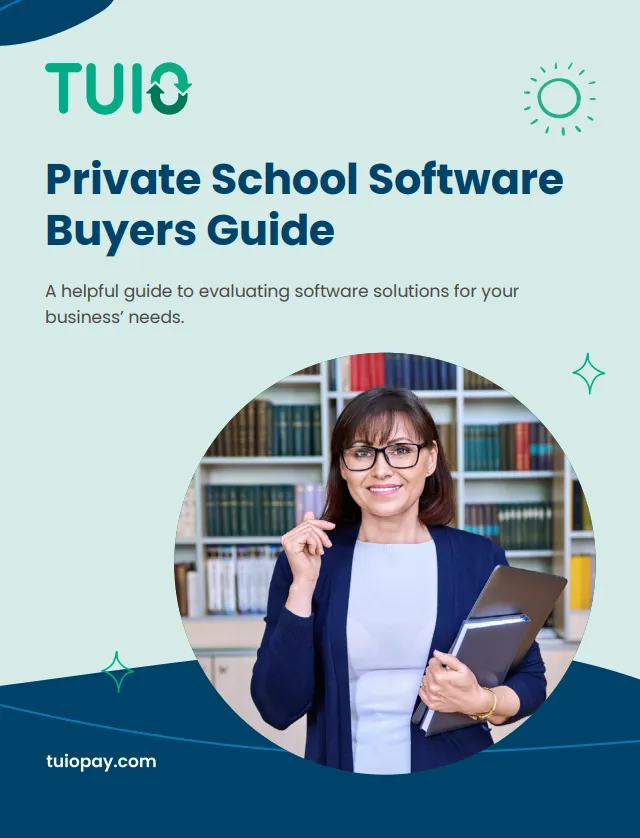Top 10 School Administration Software
Our guide reviews key features, pricing, and user feedback to help you choose the best system to manage your school’s finances, admissions, and communication.
Not sure which software suits your school’s needs best?
Download our School Software Buyer’s Guide.


Quick links
Download your free template
Ready to streamline your school's administration?
See how TUIO can save you 40+ hours a month.

Share this article:
Top 10 School Administration Software
Running a school used to be mostly about teaching. Now it’s also about running a small, complex organization. There are finances, admissions, parent emails, and compliance rules to manage. The old tools (spreadsheets, paper forms, disconnected apps) don’t work well anymore. They create extra work and lead to mistakes.
The default answer to this problem is a modern school administration software platform. But the market is crowded and noisy. This is a look at the landscape for 2025, meant to cut through the marketing language and show how the top options actually work.
The goal is to help school leaders think through the problem and make a good choice. As finances become tighter, selecting the right tools, such as effective school accounting software, is more crucial than ever.
What Makes a Platform Useful Now
To pick software that will last, it helps to see how things are changing. 4 shifts are important to highlight.
1. Software is Becoming Proactive
Most school software is reactive. A student’s grades drop, and then a meeting is scheduled.
The interesting new platforms are proactive. They use AI to find patterns in student data. They can flag a student who is at risk of falling behind before it happens. This allows for early help.
The software stops being a simple record-keeper and becomes a tool for prevention. When looking at a demo, the question isn’t “Does it have a dashboard?” but “Does it show us things we wouldn’t have noticed on our own?”
2. The School Is No Longer Just a Building
Administration and learning now happen everywhere. Parents pay tuition on their phones during a lunch break. Teachers check gradebooks from home. Students submit work on the go.
This means a school’s software must work well on a phone. Not just a mobile view of the website, but a real, functional app for parents, teachers, and students. A system with a clunky mobile experience is already obsolete.
3. The End of Data Silos
For a while, the answer to every problem was a new app. This created a mess. Financial data was in one system, academic data in another, and admissions data in a third.
The systems didn’t talk to each other. This led to manual data entry, errors, and a fractured view of the school. The obvious reaction to this is consolidation. Schools now want a “single source of truth.” They want one platform where all the data lives and connects. Vendors like Veracross and Blackbaud have built their models around this idea. A key question for any platform is: “How does it connect to our other tools and stop data from being siloed?”
4. Security Is Everyone’s Problem
Cybersecurity used to be something the IT department worried about. Now, it’s a board-level concern. Schools hold sensitive data, which makes them a target. A platform’s security is as important as its features.
Things like data encryption, two-factor authentication (2FA), and role-based access controls are no longer optional. They are the minimum requirement. Vendors should be able to demonstrate proof of security audits and compliance with regulations such as FERPA.
A Look at 10 School Administration Tools
These reviews are based on what the products do, user feedback on sites like G2 and Capterra, and how they align with the trends mentioned above.
1. TUIO
- The Idea: An all-in-one platform for private schools and daycares that focuses on simplifying finances and admin work. It is built on the ideas of simple software, clear pricing, and good support.
- What it does: Automates tuition billing, gives parents an online payment portal, has online enrollment forms, and includes parent communication tools.
- What Users Like: It’s easy to use. The customer support is live and helpful. The pricing is simple with no hidden fees (G2 Rating: 4.9/5).
- What Users Complain About: The form builder can take a little time to learn, but users say the support team helps with this.
- Pricing: Based on enrollment. No monthly fees, no annual fees, and no contracts. This makes costs easy to predict.
- Who It’s For: Small to mid-sized private schools and daycares that want to automate finances without buying a complex, expensive system.

Get Your Free Guide to Private School
Get expert insights into evaluating the best software for your school’s needs.

2. PowerSchool SIS
- The Idea: A big, comprehensive system for K-12 operations, used mainly by public school districts.
- What it does: Its core is a powerful Student Information System (SIS) that handles student data, scheduling, and complex state reporting. It also has parent portals and analytics tools.
- What Users Like: It can handle the needs of very large school districts. Its state reporting features are a major reason schools choose it.
- What Users Complain About: It can be complex to set up and learn. The interface can feel less modern than newer tools.
- Pricing: Quote-based. Priced per-student, per-year.
- Who It’s For: Large public school districts that need a powerful and compliant SIS for state reporting.
3. Gradelink
- The Idea: An all-in-one system for small to mid-sized private schools that values simplicity and affordability.
- What it does: It combines gradebook, attendance, tuition, admissions, and parent communication in one place. It is known for its simple interface.
- What Users Like: The customer support. Each school gets a dedicated representative. The flat-rate pricing is transparent and good for tight budgets (G2 Rating: 4.7/5).
- What Users Complain About: It has fewer customization options than the bigger, more complex systems.
- Pricing: A flat-rate monthly fee based on enrollment brackets. Starts around $117/month.
- Who It’s For: Small to mid-sized private or faith-based schools without a dedicated IT staff who need a system that just works.
4. Skyward
- The Idea: An Enterprise Resource Planning (ERP) system that combines student management (SIS) with business functions like finance and HR.
- What it does: It offers a full suite for financial management, payroll, hiring, and asset management that is tightly connected to its SIS.
- What Users Like: It’s a single, powerful system for managing both student and business data.
- What Users Complain About: The interface is often described as feeling dated. Adding more modules can make it expensive.
- Pricing: Quote-based annual license.
- Who It’s For: Mid-to-large districts that want to manage student data and business operations from a single vendor.
5. Infinite Campus
- The Idea: A web-based SIS built around a single database to give everyone real-time data access.
- What it does: A core SIS, a built-in Learning Management System (LMS), and an integrated payments module with a low, one-time fee.
- What Users Like: It’s very scalable for large districts and has powerful reporting tools.
- What Users Complain About: It can be complex to set up and learn. User reviews on ease of use are mixed (G2 Rating: 3.7/5).
- Pricing: Quote-based. The low-cost payment module is a notable feature.
- Who It’s For: Large districts that need scalability and strong reporting tools.
6. Alma
- The Idea: A modern, user-friendly SIS designed to be a more intuitive alternative to older, clunky systems.
- What it does: A full SIS with real-time analytics dashboards, clean parent portals, and built-in communication tools.
- What Users Like: Its modern, intuitive interface is its main selling point. It’s often seen as more cost-effective than bigger competitors.
- What Users Complain About: Being a newer platform, it has fewer third-party integrations than the established players.
- Pricing: Custom quote-based pricing.
- Who It’s For: Schools that care a lot about a modern user experience and data-driven teaching.
7. Blackbaud K-12 Solutions
- The Idea: A deeply integrated platform for private schools that connects everything from admissions and academics to fundraising.
- What it does: It combines an SIS, LMS, and enrollment management with powerful, native tools for fundraising and donor management.
- What Users Like: It is very good at managing the entire private school lifecycle, especially fundraising.
- What Users Complain About: It is very expensive. Its complexity often requires a dedicated staff member to manage it effectively.
- Pricing: Quote-based and known to be a premium-priced option.
- Who It’s For: Mid-to-large private schools where fundraising is as important as academics.
8. Veracross
- The Idea: A high-end platform for private schools built on a “one-person, one-record” single database. This means no duplicate data.
- What it does: A full suite of modules for admissions, academics, and development, all running on its unified database.
- What Users Like: The single-record design is great for data integrity. The reporting tools are very powerful.
- What Users Complain About: The implementation is long and requires a lot of work from the school. It’s also very expensive.
- Pricing: Quote-based. A premium, enterprise-level product.
- Who It’s For: Well-funded private schools that are serious about a long-term, data-first strategy and can invest the time and money in implementation.
9. Classe365
- The Idea: A modern, global platform with a flexible, modular pricing model.
- What it does: It combines an SIS, LMS, and CRM. Schools pay only for the modules they need. It has AI features and supports over 100 languages.
- What Users Like: The modular pricing gives schools control over cost and features. The interface is modern and user-friendly (G2 Rating: 4.7/5).
- What Users Complain About: While the base price is low, the cost can add up quickly as modules are added.
- Pricing: A la carte. A low base price plus additional monthly fees for major add-ons like the LMS or CRM.
- Who It’s For: A wide range of schools, especially international or multi-campus ones that need flexibility.
10. Frontline Education
- The Idea: A platform for K-12 that is especially good at managing people like staff, substitutes, and students.
- What it does: It has leading tools for absence tracking, substitute management (the old Aesop system), and hiring. It also has an SIS and other business tools.
- What Users Like: It is the market leader for K-12 human resources tasks.
- What Users Complain About: Its main strength is HR. Its SIS may not be as feature-rich as dedicated SIS competitors.
- Pricing: Quote-based.
- Who It’s For: Districts that want to solve complex HR problems like substitute management and payroll.

Get Your Free Guide to Private School
Get expert insights into evaluating the best software for your school’s needs.

How to Think About Choosing
Picking a school management system is a big decision. Here is a way to approach it.
Look at Your Problems First
Many schools start by looking at a list of features. This seems to be a mistake. A better way is to first map out the biggest administrative headaches at your school. Is the main problem chasing down tuition payments? Or is it teachers spending too much time on attendance? A clear list of problems creates a map for what to look for.
Figure Out if People Will Actually Use It
A powerful system that is confusing to use is worthless. Its value is zero if people don’t adopt it. It’s important to test the software from the viewpoint of a busy parent or a non-technical teacher. If they find it clunky, it’s the wrong choice.
Check the Support Model
The quality of support is as important as any feature. A cheap tool with poor support can be costly in terms of staff frustration and wasted time. Is support included? Is it a real person on the phone, or a ticket system with a 24-hour wait?
Understand the Real Cost
The price on the quote is not the total cost. It’s important to ask about all the other fees: implementation, data migration, training, and payment processing rates. A transparent model, like TUIO’s or Gradelink’s, is often easier to budget for than an opaque, quote-based one.
Common Questions
What is the best school administration software for small schools?
Small schools typically require software that is simple, affordable, and offers good support. They don’t have large IT teams. For these reasons, tools like Gradelink and TUIO are often a good starting point.
What is the cost of this software in 2025?
The price varies a lot. It can be under $150 a month for a small school or over $50,000 a year for a large district. The pricing models are usually per-student, flat-rate tiers, modular, or a custom quote.
What is the difference between an SIS, LMS, and ERP?
- SIS (Student Information System): The core database for student records like enrollment, schedules, grades.
- LMS (Learning Management System): The classroom tool for assignments, content, and online discussion.
- ERP (Enterprise Resource Planning): A bigger suite that includes an SIS and often an LMS, plus business tools for finance and HR.
- Are integrations important? Yes, very. A school’s main software should integrate smoothly with other tools, such as Google Classroom or QuickBooks. Good integrations stop people from having to do duplicate, error-prone data entry. For more information on this topic, sites like EdTech Magazine are a valuable resource.
A Final Thought
Choosing software is a decision about how your school will operate for the next five to ten years. The market is moving toward integrated, cloud-based tools. The “best” one is simply the one that best fits a school’s specific size, budget, and problems.
For schools looking for a simpler way to handle their operations, especially finances and enrollment, without the complexity of a big enterprise system, platforms like TUIO offer a clear alternative. The right tool can free up a surprising amount of time and allow administrators to focus on the things that matter more than paperwork.
Ready to streamline your school's administration?
See how TUIO can save you 40+ hours a month.

Next article








Subscribe for our newsletter
- Catch up on new articles before anyone else
- Tips and tricks to automate your admin work
- Only once a month!